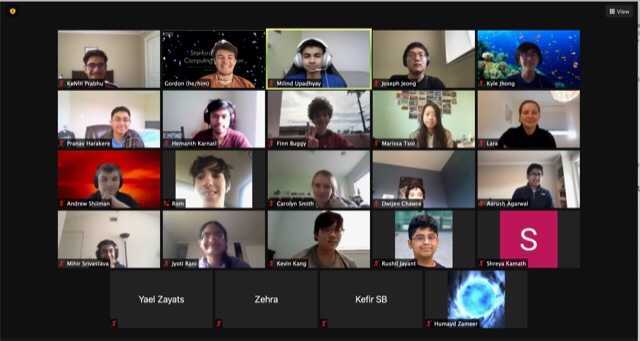As a high schooler, Gordon Martinez-Piedra ’22 remembered being “terrified” of anything that had to do with the word “quantum.” Now, he is partnering with other college students to make quantum computing more accessible to high schoolers.
Despite his initial fear, Martinez-Piedra became passionate about the subject at Stanford by taking related classes and teaching himself material that piqued his interest. He eventually came to the realization that this subject is “so unintuitive to everyone, it doesn’t really matter your background.” Everyone starts at “square one,” he said.
He eventually joined the Stanford Quantum Computing Association (SQCA), which aims to foster community in the quantum computing field and produce new solutions to problems through paper-reading groups, hackathons and continuous projects. With a newfound passion for improving quantum computing literacy, Martinez-Piedra interned at IBM in the summer of 2019. There, he met fellow interns then-Ph.D. candidate Kanav Setia of Dartmouth College and then-undergraduate Jason Necaise of the Massachusetts Institute of Technology. That summer, their first idea of many surfaced: a company that writes software for people working on quantum chemistry.
After examining the landscape of how many people were using such software, they realized that instead of advancing quantum chemistry alone, they could have an effect on the larger industry.
“One of the key things in order for the field to progress was to bring more people in,” said Setia, whose focus of research is algorithms in quantum chemistry. “In order to do that you had to lower the steep learning curve associated with quantum computing.”
Necaise and Setia went on to found and pilot qBraid, a quantum computing platform for learning, programming and running quantum algorithms with courses for experience levels ranging from high school to graduate school. This year, in addition to organizing boot camps, campus events and outreach efforts to increase accessibility to the field of quantum computing, Martinez-Piedra has organized a partnership between SQCA and qBraid to support new initiatives to bring the online platform to high schools in the Stanford network, at no cost.
“It’s like signing up for an email address, and that’s how easy it is to access this platform,” Martinez-Piedra said. “You don’t have to have any understanding of computer science whatsoever.”
qBraid instructors, who range from postdoctoral scholars, researchers and professors to students such as Martinez-Piedra, host lectures and workshops and assign graded work, providing an atmosphere of collaboration for those who sign up. Students are encouraged to work on their own projects and come up with original code.
“All the tools have been created in such a way that people come and hack,” Setia said. From the moment after they log in, students have the ability to conduct their own research on the platform: for example, by building chemistry simulations and cryptographic algorithms.
There are three courses currently listed on the qBraid website: QuBes, aimed at juniors and seniors in high school, QuInts, for those in undergraduate programs or professionals with some mathematical background and the upcoming QuPro, a hands-on collection of tutorials for graduate students and researchers in the field.
After an introduction to the QuBes course, the curriculum progresses to how to build quantum circuits. This software runs the code remotely, sending the instructions to IBM quantum computers and then relaying the results back.
Milind Upadhyay is a current qBraid student from Mountain View High School who is interested in computer science and quantum physics. He said that when his teacher sent him the link to sign up for the class, he saw the opportunity as a bridge between his interests.
“In the first lesson, they showed the double-slit experiment so that we could understand the superposition,” he said. “And then they showed us how to describe this superposition, using a vector of complex numbers.”
Upadhyay is interested in the phenomenon of why and how measuring properties of quantum objects can appear to affect the measurements themselves. For him, office hours are a time to go over assignments with Martinez-Piedra and delve into conversations about whether the universe is truly deterministic, or “quantum philosophy,” as he put it.
Martinez-Piedra said that these conversations sometimes become divergent and lead to engaging conversations about free will, metaphysics and quantum cryptography. It gives him a rewarding opportunity to see how “engaged and also intelligent these kids are to be able to ask very smart questions.”
Reflecting on his connections with Setia and Necaise, “I think we both constantly reassure each other how much we enjoy this partnership,” Martinez-Piedra said.
Currently, quantum computers present a major problem: They can perform simulations or process information for a little while, but after that, the calculations can become derailed when the computer’s quantum state decoheres.
When asked what the eventual large-scale applications could be beyond the roadblocks, Setia said that he does not know for sure.
However, Setia did note various areas of promise. There is a “good chance” that 20 to 30 years from now, diseases will be cured by drugs developed primarily using quantum computers, due to the newfound speed of running simulations, he said.
Additionally, he said that government agencies and security agencies will use the technology to store communications and other information securely. It is even possible for the current quantum circuits in Minecraft or computer games of tic-tac-toe and chess to evolve into teleportation technology or boost efforts to develop more sophisticated artificial intelligence.
Still, the evolution of this technology is exactly that: an iterative process that won’t happen overnight.
“In summary, the quantum hardware is just not reliable enough, and it won’t be for a long time for a lot of these large-scale applications,” Setia said.
“This is something we’re really excited about and we know that we wanted to make other kids really excited about to give it a bit of impetus,” Martinez-Piedra said. “This is something that can spread.”
